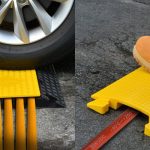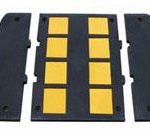Introduction
Explanation of the importance of speed bumps
Speed bumps are an essential traffic calming measure that helps to reduce the speed of vehicles on roads and in parking lots. They are particularly important in areas where there are high volumes of pedestrian traffic, such as schools, hospitals, and residential areas. Speed bumps are also useful in reducing the number of accidents caused by speeding vehicles, which can result in serious injuries or fatalities. Additionally, speed bumps can help to reduce noise pollution and improve the overall safety of the community. Therefore, it is crucial to choose the right type of speed bump that is effective in slowing down vehicles while also being durable and long-lasting.
Overview of the article
In this article, we will be discussing the differences between heavy-duty speed bumps and traditional speed bumps. We will explore the advantages and disadvantages of each type of speed bump, as well as the situations in which they are most effective. By the end of this article, you will have a better understanding of which type of speed bump is best suited for your specific needs. Whether you are looking to slow down traffic in a residential area or control the speed of vehicles in a commercial parking lot, this article will provide you with the information you need to make an informed decision.
What are Heavy Duty Speed Bumps?
Definition of heavy duty speed bumps
Heavy duty speed bumps are designed to withstand heavy traffic and larger vehicles such as trucks and buses. They are typically made of durable materials such as rubber or concrete and have a higher profile than traditional speed bumps. Heavy duty speed bumps are often used in industrial areas, parking lots, and other high-traffic areas where vehicles are moving at higher speeds. They are designed to slow down vehicles and reduce the risk of accidents, making them an effective traffic calming measure. Compared to traditional speed bumps, heavy duty speed bumps are more durable and can withstand more wear and tear over time.
Materials used in heavy duty speed bumps
Heavy duty speed bumps are designed to withstand heavy traffic and extreme weather conditions. As a result, they are made from durable materials such as rubber, plastic, or concrete. Rubber speed bumps are the most popular choice due to their ability to absorb impact and reduce noise. They are also resistant to oil, chemicals, and UV rays, making them ideal for outdoor use. Plastic speed bumps are lightweight and easy to install, but they may not be as durable as rubber or concrete. Concrete speed bumps are the most durable option, but they are also the most expensive and difficult to install. Overall, the choice of material for heavy duty speed bumps depends on the specific needs of the location and the amount of traffic it receives.
Advantages of heavy duty speed bumps
Heavy duty speed bumps have several advantages over traditional speed bumps. Firstly, they are more durable and can withstand heavy traffic and harsh weather conditions. This means that they require less maintenance and replacement, resulting in cost savings in the long run. Secondly, heavy duty speed bumps are more effective in slowing down vehicles, as they are higher and wider than traditional speed bumps. This reduces the risk of accidents and improves safety for pedestrians and drivers alike. Lastly, heavy duty speed bumps are more visible, thanks to their bright colors and reflective markings. This makes them easier to spot, even in low light conditions, and helps to prevent accidents. Overall, heavy duty speed bumps are a better choice for areas with high traffic volume and heavy vehicles.
What are Traditional Speed Bumps?
Definition of traditional speed bumps
Traditional speed bumps are the most common type of traffic calming measure used to slow down vehicles in areas with high pedestrian traffic. They are typically made of asphalt or concrete and are designed to be between 3 and 4 inches high. Traditional speed bumps are usually 12 to 14 feet long and are placed perpendicular to the direction of traffic. They are effective in slowing down vehicles, but they can also cause discomfort to drivers and passengers, as well as damage to vehicles if they are driven over too quickly.
Materials used in traditional speed bumps
Traditional speed bumps are typically made from asphalt or concrete and are designed to slow down vehicles by creating a raised surface on the road. These materials are durable and can withstand heavy traffic, but they can also be expensive to install and maintain. Additionally, traditional speed bumps can be difficult to remove or adjust if they need to be relocated or modified. Some communities have also expressed concerns about the environmental impact of using concrete or asphalt, as these materials can contribute to urban heat islands and increase runoff. As a result, many municipalities are exploring alternative materials for speed bumps, including recycled rubber and plastic.
Advantages of traditional speed bumps
Advantages of traditional speed bumps include their affordability and ease of installation. Traditional speed bumps are made of materials such as asphalt or concrete and can be easily installed by a paving contractor. They are also relatively inexpensive compared to heavy-duty speed bumps, making them a popular choice for municipalities and businesses on a budget. Additionally, traditional speed bumps are effective at slowing down traffic and reducing speeds in areas where pedestrian safety is a concern.
Comparison of Heavy Duty Speed Bumps and Traditional Speed Bumps
Effectiveness in slowing down vehicles
When it comes to slowing down vehicles, both heavy duty speed bumps and traditional speed bumps are effective. However, heavy duty speed bumps are designed to slow down vehicles at a much slower speed than traditional speed bumps. This is because heavy duty speed bumps are larger and have a steeper incline, which forces drivers to slow down significantly. Traditional speed bumps, on the other hand, are smaller and have a gentler incline, which allows drivers to maintain a slightly higher speed. Ultimately, the effectiveness of either type of speed bump depends on the specific needs of the area in which they are installed.
Durability and maintenance
When it comes to durability and maintenance, heavy-duty speed bumps are the clear winner. Made from high-quality materials such as recycled rubber or plastic, these speed bumps are designed to withstand heavy traffic and harsh weather conditions. They require minimal maintenance and can last for years without needing to be replaced. On the other hand, traditional speed bumps made from asphalt or concrete can crack and deteriorate over time, requiring frequent repairs and replacements. This not only adds to the cost but also causes inconvenience to drivers and pedestrians. Therefore, if you’re looking for a long-lasting and low-maintenance solution, heavy-duty speed bumps are the way to go.
Cost comparison
When it comes to cost, heavy-duty speed bumps are generally more expensive than traditional speed bumps. This is because heavy-duty speed bumps are made of more durable materials, such as rubber or concrete, which can withstand heavier traffic and last longer. However, the initial investment in heavy-duty speed bumps can pay off in the long run, as they require less maintenance and replacement over time. Traditional speed bumps, on the other hand, may be more affordable upfront, but they may need to be replaced more frequently due to wear and tear. Ultimately, the decision between heavy-duty and traditional speed bumps will depend on the specific needs and budget of each individual project.
Environmental impact
Environmental impact: When it comes to the environmental impact, heavy-duty speed bumps are a better option than traditional speed bumps. Heavy-duty speed bumps are made of recycled rubber, which means they are eco-friendly and do not harm the environment. On the other hand, traditional speed bumps are made of asphalt or concrete, which are not eco-friendly and can harm the environment. Moreover, heavy-duty speed bumps are designed to last longer than traditional speed bumps, which means they do not need to be replaced as often, reducing waste and saving resources. Therefore, if you are looking for a speed bump that is environmentally friendly, durable, and long-lasting, heavy-duty speed bumps are the way to go.
Which is Better?
Factors to consider when choosing between heavy duty and traditional speed bumps
When deciding between heavy duty and traditional speed bumps, there are several factors to consider. Firstly, heavy duty speed bumps are typically more durable and can withstand heavier traffic volumes and larger vehicles. They are also often more visible due to their larger size and bright colors. However, traditional speed bumps are often more cost-effective and can be easier to install and maintain. Additionally, they may be more appropriate for areas with lower traffic volumes or where speed reduction is not a top priority. Ultimately, the decision between heavy duty and traditional speed bumps will depend on the specific needs and circumstances of each location.
Conclusion
In conclusion, the choice between heavy duty speed bumps and traditional speed bumps ultimately depends on the specific needs and circumstances of the location. Heavy duty speed bumps are ideal for high traffic areas where heavy vehicles are present, while traditional speed bumps are suitable for low traffic areas with lighter vehicles. It is important to consider factors such as speed limit, traffic volume, and vehicle types before deciding which type of speed bump to install. Ultimately, the goal is to ensure the safety of drivers, pedestrians, and property, and both types of speed bumps can effectively serve this purpose when used appropriately.
If you’re looking for a heavy-duty speed bump that can withstand heavy traffic and extreme weather conditions, then the UNIMAT Hardware Recycled Rubber Speed Bump is the perfect solution for you. Made from high-quality recycled rubber, this speed bump is designed to last for years without cracking or fading. Plus, it comes with all the necessary hardware and instructions for easy installation. So, why wait? Head over to https://www.amazon.com/UNIMAT-Hardware-Recycled-Especially-Included/dp/B09RBGCBRY and order your UNIMAT Hardware Recycled Rubber Speed Bump today!






